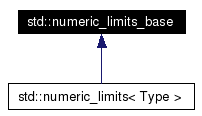
Inheritance diagram for std::numeric_limits_base:

Static Public Attributes | |
| static const bool | is_specialized |
| static const int | digits |
| static const int | digits10 |
| static const bool | is_signed |
| static const bool | is_integer |
| static const bool | is_exact |
| static const int | radix |
| static const int | min_exponent |
| static const int | min_exponent10 |
| static const int | max_exponent |
| static const int | max_exponent10 |
| static const bool | has_infinity |
| static const bool | has_quietNaN |
| static const bool | has_signalingNaN |
| static const float_denorm_style | has_denorm |
| static const bool | has_denorm_loss |
| static const bool | is_iec559 |
| static const bool | is_bounded |
| static const bool | is_modulo |
| static const bool | traps |
| static const bool | tinyness_before |
| static const float_round_style | round_style |
The static const members are usable as integral constant expressions.
Definition at line 192 of file limits.
|
|
The number of |
|
|
The number of base 10 digits that can be represented without change. |
|
|
See std::float_denorm_style for more information. |
|
|
"True if loss of accuracy is detected as a denormalization loss, rather than as an inexact result." [18.2.1.2]/42 |
|
|
True if the type has a representation for positive infinity. |
|
|
True if the type has a representation for a quiet (non-signaling) "Not a Number." |
|
|
True if the type has a representation for a signaling "Not a Number." |
|
|
"True if the set of values representable by the type is finite. All built-in types are bounded, this member would be false for arbitrary precision types." [18.2.1.2]/54 |
|
|
True if the type uses an exact representation. "All integer types are exact, but not all exact types are integer. For example, rational and fixed-exponent representations are exact but not integer." [18.2.1.2]/15 |
|
|
True if-and-only-if the type adheres to the IEC 559 standard, also known as IEEE 754. (Only makes sense for floating point types.) |
|
|
True if the type is integer. |
|
|
True if the type is modulo, that is, if it is possible to add two positive numbers and have a result that wraps around to a third number that is less. Typically false for floating types, true for unsigned integers, and true for signed integers. |
|
|
True if the type is signed. |
|
|
This will be true for all fundamental types (which have specializations), and false for everything else. |
|
|
The maximum positive integer such that |
|
|
The maximum positive integer such that 10 raised to that power is in the range of representable finite floating point numbers. |
|
|
The minimum negative integer such that |
|
|
The minimum negative integer such that 10 raised to that power is in the range of normalized floating point numbers. |
|
|
For integer types, specifies the base of the representation. For floating types, specifies the base of the exponent representation. |
|
|
See std::float_round_style for more information. This is only meaningful for floating types; integer types will all be round_toward_zero. |
|
|
True if tinyness is detected before rounding. (see IEC 559) |
|
|
True if trapping is implemented for this type. |
 1.4.2
1.4.2